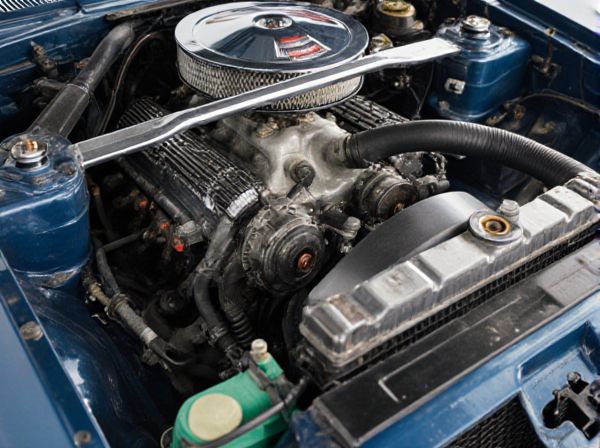
Photo illustration: Pushrod vs Overhead Cam
A pushrod engine uses long rods to transfer motion from the camshaft, typically located in the engine block, to the valves, resulting in a more compact design but limited high-RPM performance. Overhead cam (OHC) engines position the camshaft directly above the valves, enabling more precise valve timing, better efficiency, and higher engine speeds. Your choice between pushrod and overhead cam will impact engine complexity, performance potential, and maintenance requirements.
Table of Comparison
| Feature | Pushrod Engine | Overhead Cam (OHC) Engine |
|---|---|---|
| Valve Actuation | Pushrods transfer motion from camshaft located in engine block to valves | Camshaft located directly above valves, operating them via rocker arms or directly |
| Engine Design | Compact and simpler design, fewer moving parts | More complex, larger cylinder head due to camshaft placement |
| Performance | Lower maximum RPM, limited valve control | Higher RPM capability, precise valve timing for improved performance |
| Maintenance | Generally easier and cheaper to maintain | More complex, potentially higher maintenance cost |
| Common Usage | Traditional V8 engines, American muscle cars, trucks | Modern cars, sports cars, high-performance engines |
| Fuel Efficiency | Typically less fuel efficient due to valve timing limitations | Better fuel efficiency with optimized valve timing |
Introduction to Pushrod and Overhead Cam Engines
Pushrod engines use a camshaft located within the engine block, operating the valves through pushrods and rocker arms, which provides a compact design ideal for low-end torque and simplicity. Overhead cam (OHC) engines position the camshaft directly above the valves in the cylinder head, allowing for more precise valve timing, higher RPM potential, and improved fuel efficiency. The choice between pushrod and overhead cam setups influences engine performance characteristics, complexity, and maintenance requirements.
Basic Design Differences
Pushrod engines feature a camshaft located within the engine block, using rods to activate the valves, resulting in a more compact design with fewer moving parts. Overhead cam (OHC) engines position the camshaft directly above the valves in the cylinder head, allowing for more precise valve timing and higher engine speeds. The primary design difference impacts engine efficiency, performance, and maintenance complexity, with pushrod engines typically being more robust but less efficient than overhead cam designs.
Historical Development and Evolution
Pushrod engines, with origins tracing back to the early 20th century, utilized a camshaft located in the engine block to operate valves via pushrods, offering a simpler and more compact design suited for early automotive engineering. Overhead cam (OHC) configurations emerged mid-century, positioning the camshaft above the cylinder head to directly actuate valves, improving precision, high-RPM performance, and efficiency, leading to widespread adoption in modern engines. The evolution from pushrod to overhead cam designs reflects advancements in materials, manufacturing, and performance demands, marking significant milestones in internal combustion engine technology.
Performance and Power Output
Pushrod engines deliver strong low-end torque due to their compact design and shorter valvetrain, enhancing performance in muscle cars and trucks where initial acceleration is key. Overhead cam (OHC) engines achieve higher RPMs and improved airflow with direct valve actuation, resulting in greater peak power output and efficiency suitable for high-performance and sports cars. The overhead cam layout typically enables more precise valve timing, optimizing combustion and power delivery compared to the traditional pushrod setup.
Fuel Efficiency Comparison
Pushrod engines typically offer better fuel efficiency at low to moderate RPMs due to their simpler valvetrain design and reduced friction. Overhead cam (OHC) engines provide more precise valve timing control, improving fuel combustion and power output, which can enhance fuel efficiency at higher RPMs. Overall, pushrod engines excel in fuel economy for everyday driving, while OHC engines optimize efficiency during performance-oriented conditions.
Maintenance and Reliability
Pushrod engines typically require less frequent maintenance due to their simpler valve train design, resulting in fewer moving parts and reduced wear. Overhead cam (OHC) engines, while offering better high-RPM performance, often demand more precise maintenance schedules and can have higher costs related to timing belt or chain replacements. Reliability in pushrod engines remains strong for everyday use, whereas OHC engines may benefit from more advanced materials but require diligent upkeep to maintain optimal function.
Cost and Manufacturing Considerations
Pushrod engines typically have lower manufacturing costs due to simpler valve train components and fewer machining requirements, making them cost-effective for mass production. Overhead cam (OHC) engines involve more complex parts like camshafts positioned above the valves, increasing precision machining and assembly expenses. These higher costs for OHC designs are justified by improved engine efficiency and performance but pose greater initial investment compared to pushrod configurations.
Applications in Modern Vehicles
Pushrod engines remain prevalent in American muscle cars and trucks due to their compact design and strong low-end torque, ideal for heavy-duty and performance applications. Overhead cam (OHC) engines dominate in modern passenger cars and luxury vehicles, offering higher RPM capabilities, improved fuel efficiency, and stricter emissions compliance through precise valve timing. Hybrid and electric vehicles increasingly pair with OHC engines to optimize power delivery and meet advanced environmental standards.
Pros and Cons Summary
Pushrod engines offer a compact design, typically resulting in a lower center of gravity and reduced engine height, which benefits vehicle handling and packaging. However, they generally have limited valve timing precision and lower redline potential compared to overhead cam (OHC) engines, impacting high-RPM performance. Overhead cam engines provide better valve control, improved efficiency, and higher RPM capabilities but often come with increased complexity and engine height, affecting vehicle design constraints.
Which Engine Type is Right for You?
Pushrod engines offer a compact design and strong low-end torque, making them ideal for vehicles that require durability and power in tight spaces, such as trucks and muscle cars. Overhead Cam (OHC) engines deliver higher RPM capability and improved fuel efficiency due to more precise valve control, favoring performance-oriented cars and fuel-conscious drivers. Choosing the right engine depends on your priorities: pushrod for rugged, low-speed power or OHC for efficiency and high-revving performance.
 caratoz.com
caratoz.com